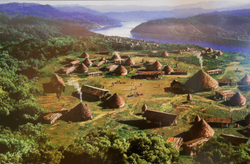The traditional tribal diet comprised food that was hunted, gathered, or grown. Hunted animals included deer, bear, bird, squirrel, and rabbit. The Cherokee would gather such foods as wild greens, ramps (leeks), nuts, and berries, while growing the “Three Sister,” which are corn, beans, and squash. The “Three Sisters” are so called because the plants would commonly be grown together. Corn stalks would grow tall, allowing the bean vines to twine around them. Squash, a low-lying plant, would fill out the bottom of the growing area.
After contact with the Europeans, the Cherokee began to grow fruit, such as watermelon, and to care for livestock, such as chicken. They also began to use metal cooking vessels instead of the traditional clay. Today, the Cherokee people combine a modern diet with many of their traditional foods, such as the Three Sisters and local dishes such as Qualla Boundary fry bread.




















Food
Cherokee fashioned clothing out of many natural resources available, such as animal skin and feathers. They were noted for their fondness of decoration, whether by plaiting hair with silver and quills or fastening wampum stones into diadems around their temples. Contact with Europeans introduced them to other types of linen, and they would adorn parts of their clothing, such as legware and moccasins, with lace. The clothing covering the main body area (waist, torso, and chest) consisted of a shirt and a flap, often blue in color, that fell to the knees and was drawn round the waist with a belt. (Bartram; Walker).
A description of three Cherokee chiefs taken to London after the Anglo-Cherokee War (1758-1761) was recorded by James Boswell in 1762 as follows:
“They were dressed in their own country habit, with only a shirt, trousers, and mantle round them, their heads adorned with shells, feathers, ear-rings and other trifling ornaments…. A house was taken for them in Suffolk street, and clothes in the English fashion were given to them. On the 8th of July they were introduced to the King. The head chief’s dress was a rich blue mantle covered with lace; his head richly ornamented, and on his breast a silver gorget, with his Majesty’s arms engraved. The other two chiefs were in scarlet, richly adorned with lace, and gorgets of plate on their breasts…The chiefs are men of middling stature, seem to have no hair upon their heads, and wear a kind of skullcap. Their faces and necks are so besmeared with a coarse sort of paint, of a brick-dust colour, that it is impossible to say of what complexion they are. Their necks are streaked with blue paint, something resembling blue veins in a fine skin.”
Today, Cherokee wear modern clothes, but still keep their traditional garments for ceremonial and other special occasions. They also incorporate parts of their heritage into everyday wear, especially such facets as jewelry.














Clothing
Cherokee often built their houses into settlements of around 10-60 homes that centered around the townhouse, a circular building 35-60 ft. in diameter with timber frames and a roof of bark, thatch, and earth. The houses’ structure reflected the townhouse, but on a smaller scale, and would often be separated a couple hundred feet from the townhouse by an open plaza area for town meetings. Houses themselves were spaced between 30-50 ft. apart.
The townhouse itself would be built upon an earthen mound, sometimes 30 ft. high, that was constructed by burying a prominent town leader within a circle of stones. Women brought baskets of earth to place atop the burial to form the mound. After completion of the townhouse, a large hearth fire was litten, from which each individual house’s own hearth fire would be lit during yearly rituals. Sometimes there would be a winter and summer townhouse. (Rodning)
The townhouses would last for 15-20 years, and then would be dismantled and rebuilt with each successive generation at a different location. After contact with the Europeans, townhouses became larger, and were often rebuilt over the same spot (or a very near spot), perhaps as a way to assert identity and land claims. (Rodning)
During migratory periods, the Cherokee used teepees as portable shelters. On reservation land, they built log cabins similar to those in style, and likewise today, the Cherokee live in homes of a modern style.
 |  |
|---|---|
 |  |
 |  |
 |  |
Shelter
Food
-
Knowing that many Indian tribes planted the Three Sisters (corn, beans, and squash), what does this suggest about intertribal contact and cultural similarity?
-
What are some of the differences you see among Cherokee, Sioux, and Navajo diets? What factors may have influenced these?
Clothing
-
What do you think of the description of Cherokee chiefs from the mid 1700s? What stands out?
-
Why do you think the English gave the Chiefs English garb to wear? Why do you think the Chiefs accepted it?
-
Why do you think the Europeans compared traditional Cherokee garb to that of their own cultural backgrounds, such as describing the flap worn from the waist as akin to ancient Roman breeches or the kilt of the Scottish Highlanders?
Shelter
-
What does the cyclical nature of Cherokee townhouses (rebuilt about every generation) say about their culture? How is this similar and different to our own town-building practices today?
-
How did contact with the Europeans influence Cherokee town practices? Why?
-
How did respect for the dead and burial practices influence Cherokee construction? How does this compare to the Navajo?
-
What is the role of the hearth fire?
-
How do you think such construction practices may have impacted the everyday facets of life for the Cherokee? For example, how might our culture be different if we assembled at a graveyard for town meetings, in honor and respect of our ancestors?